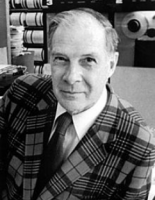










Richard Wesley Hamming was an American mathematician whose work had many implications for computer science and telecommunications. His contributions include the Hamming code (which makes use of a Hamming matrix), the Hamming window, Hamming numbers, sphere-packing (or Hamming bound) and the Hamming distance.
Early Life
Richard Wesley Hamming was born in Chicago, Illinois, on February 11, 1915,the son of Richard J. Hamming, a credit manager,and Mabel G. Redfield.He grew up in Chicago, where he attended Crane Technical High School and Crane Junior College.
Hamming initially wanted to study engineering, but money was scarce during the Great Depression, and the only scholarship offer he received came from the University of Chicago, which had no engineering school. Instead, he became a science student, majoring in mathematics,and received his Bachelor of Science degree in 1937.He later considered this a fortunate turn of events. "As an engineer," he said, "I would have been the guy going down manholes instead of having the excitement of frontier research work."
He went on to earn a Master of Arts degree from the University of Nebraska in 1939, and then entered the University of Illinois at Urbana-Champaign, where he wrote his doctoral thesis on Some Problems in the Boundary Value Theory of Linear Differential Equations under the supervision of Waldemar Trjitzinsky. His thesis was an extension of Trjitzinsky's work in that area. He looked at Green's function and further developed Jacob Tamarkin's methods for obtaining characteristic solutions.While he was a graduate student, he discovered and read George Boole's The Laws of Thought.
The University of Illinois at Urbana-Champaign awarded Hamming his Doctor of Philosophy in 1942, and he became an Instructor in Mathematics there. He married Wanda Little, a fellow student, on September 5, 1942,immediately after she was awarded her own Master of Arts in English literature. They would remain married until his death, but had no children.In 1944, he became an Assistant Professor at the J.B. Speed Scientific School at the University of Louisville in Louisville, Kentucky.
Hamming code
Hamming worked at Bell Labs in the 1940s on the Bell Model V computer, an electromechanical relay-based machine with cycle times in seconds. Input was fed in on punched cards, which would invariably have read errors. During weekdays, special code would find errors and flash lights so the operators could correct the problem. During after-hours periods and on weekends, when there were no operators, the machine simply moved on to the next job.
Hamming worked on weekends, and grew increasingly frustrated with having to restart his programs from scratch due to the unreliability of the card reader. Over the next few years, he worked on the problem of error-correction, developing an increasingly powerful array of algorithms. In 1950, he published what is now known as Hamming Code, which remains in use today in applications such as ECC memory.
Turing Award, Association for Computing Machinery, 1968.
IEEE Emanuel R. Piore Award, 1979.
Member of the National Academy of Engineering, 1980.
Harold Pender Award, University of Pennsylvania, 1981.
IEEE Richard W. Hamming Medal, 1988.
Fellow of the Association for Computing Machinery, 1994.
Basic Research Award, Eduard Rhein Foundation, 1996.
The IEEE Richard W. Hamming Medal, named after him, is an award given annually by the Institute of Electrical and Electronics Engineers (IEEE), for "exceptional contributions to information sciences, systems and technology", and he was the first recipient of this medal.The reverse side of the medal depicts a Hamming parity check matrix for a Hamming error-correcting code.